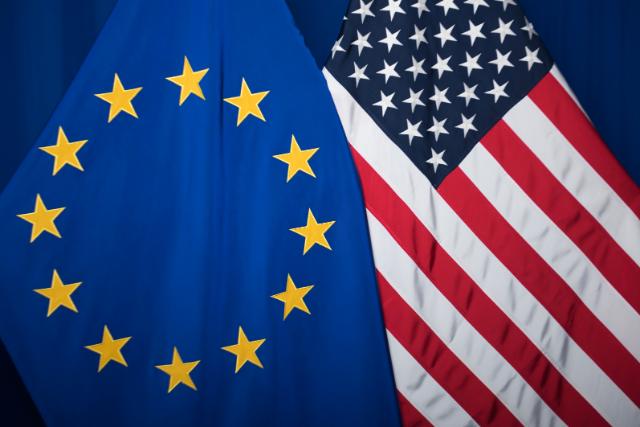Europe and the US, once at odds over clean energy policies, have joined forces in a bid to counter China’s dominance in the industry. After years of bickering, both sides are now acknowledging that they have a common enemy in the form of China, which is currently leading the race in the production of clean energy technology.
In a recent meeting between President Joe Biden and European Commission President Ursula von der Leyen, both sides vowed to strengthen critical mineral supply chains between the US and EU, a move that would allow EU companies to benefit from key electric vehicle tax credits in the US.
Additionally, the governments agreed to engage in a dialogue on subsidy transparency and set a deadline for completing negotiations on standards to promote steel and aluminum made with fewer carbon emissions.
The message from Biden and von der Leyen was clear: whatever differences they may still have, the US and Europe both need to contain the same threat, and that is China. In their statement, they spoke about cooperation, and singled out China’s “non-market policies and practices” in announcing a dialogue on clean energy.
Join the Movement for a Stronger Europe
Welcome to Forward Europe, a political party committed to the rise of Europe as a force for good in the world.
Please sign up for our weekly newsletter and stay informed about the latest developments in the fight for a sovereign Europe.
Together, we can make a difference.
Subscribe now!
The dialogue will “coordinate our respective incentive programs so that they are mutually reinforcing,” they said. “Both sides will take steps to avoid any disruptions in transatlantic trade and investment flows that could arise from their respective incentives.”
This newfound cooperation marks a significant shift in the relationship between the US and Europe. It was only a few months ago that the EU was constantly criticizing the US over Biden’s climate law and its $369 billion of green incentives. However, with China’s rapid rise to dominance in the clean energy sector, both sides have realized that they need to work together to counter China’s influence.
A Pledge to Deepen Cooperation
In their joint statement, the US and EU leaders said they “will deepen our cooperation on diversifying critical mineral and battery supply chains,” noting that official dialogue between the two on the Inflation Reduction Act “has taken practical steps forward on identified challenges to align our approaches.”
The US helped us enormously when we wanted to get rid of the Russian fossil fuel dependency — you helped us tremendously by delivering more [liquefied natural gas], you helped us through the energy crisis.
Ursula von der Leyen, President of the European Commission
The US and EU have also agreed to push back on Russia for its invasion of Ukraine, with von der Leyen telling Biden the US “helped us enormously when we wanted to get rid of the Russian fossil fuel dependency — you helped us tremendously by delivering more [liquefied natural gas], you helped us through the energy crisis.” She called it “great that there is such a massive investment in new and clean technologies” and said the EU wants “to match it” with its Green Deal plan.
A Focus on Critical Minerals
Both the US and EU have realized that they need to work together to secure their supply chains for critical minerals, which are essential to the production of clean energy technology. China currently dominates the global supply of these minerals, and both the US and EU are keen to reduce their reliance on China.
To that end, both sides have agreed to strengthen their critical minerals supply chains, with the US committing to help EU companies take advantage of key electric vehicle tax credits. This will allow EU companies to increase their production of electric vehicles, while reducing their dependence on China for the minerals needed to produce them.
A Shared Vision for Clean Energy
Despite their differences, both the US and EU share a common vision for the future of clean energy. They both want to reduce their reliance on fossil fuels and promote the use of renewable energy sources such as wind and solar power. They also want to increase the production of electric vehicles and reduce their dependence on oil.
By working together, the US and EU can pool their resources and expertise to accelerate the development of clean energy technology, while reducing their dependence on China. By doing so, we can avoid trade disruptions, and their respective clean energy industries can mutually reinforce each other. The US and EU can then take on China’s non-market policies and practices that hinder their progress in clean energy.

We, at Forward Europe, believe that this is a promising step towards creating a more sustainable world. We hope that the cooperation between the US and EU will bring positive changes in the production and use of clean energy. We urge the two superpowers to continue to work together towards a cleaner future.
Conclusion
The meeting between President Biden and President von der Leyen is a significant event in the global effort towards a sustainable future. The US and EU have acknowledged their differences and taken the first step in finding common ground. They have agreed to work together to overcome the challenges they face in the clean energy race, with the ultimate goal of curbing China’s dominance in the industry.
At Forward Europe, we believe that this agreement is a positive development for the planet. We encourage the US and EU to build on this momentum and continue to cooperate in the development and deployment of clean energy technologies. Together, they can create a better, cleaner, and more sustainable future for all of us.






